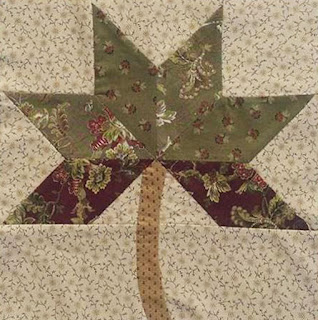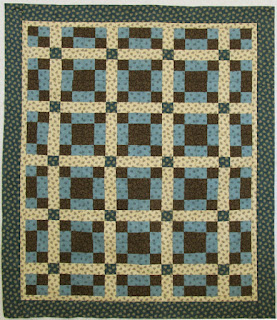Block 3 Sweet Gum Leaf by Becky Brown
Becky's used prints from my Old Cambridge Pike line for Moda.
This map of the trails was drawn about 1907 after most native tribes were moved elsewhere and states and cities were established. You can see the red road loops south of Independence as it starts northwest up to the Platte River.
Why go south to travel north and ultimately west?
One reason was to find the easiest crossing. Real mountains lay far ahead but rivers and creeks offered serious obstacles early in the voyage. Following long-established trails avoided steep banks and unstable river beds.
"She didn't Get Her Feet Wet"
following Wadsworth's Guide, 1858
How did travelers know where to turn?
They hired guides (some more reliable than others.)
And they bought guide books and maps.
Wadsworth's National Wagon Road Guide from
St. Joseph and Council Bluffs, 1858
1849 guide to California and
"The Various Overland Routes"
Differing advice mapped different routes. In 1850 Anna Maria Morris's trip south to Santa Fe took a trail north of the Kansas River, where they had to cross Stranger Creek and then Grasshopper Creek. On May 22nd they waited from 8:30 a.m. until 1 to cross the Stranger. She wrote a letter to her father:
"In crossing the creek the wagons stalled…altho' we were stationary three whole hours we did not get very much out of patience---The Dr. had two parlor chairs left in the mud broken all to pieces---I fear mine will go next---We crossed the Stranger in safety tho' the banks are very steep indeed."
"They Take a Cut Off"
Wadsworth's guide included humorous drawings
of the consequences of ignoring their advice.
Small towns and trading posts evolved along these established trails. One was Gum Springs, a day out of Westport, Missouri. Gum Springs was an old settlement in the Shawnee's reserve, near several Christian missions to the tribe that had been removed from Ohio.
Sweet Gum Leaf by Denniele Bohannon
Denniele's pink and red are from my
Alice's Scrapbag line for Moda.
The town was named for a grove of gum trees, probably sweet gums. Decades later its name was changed to Shawnee. The Grasshopper River mentioned above became the Delaware (named for the tribe and not the state or the English Lord.) One problem in tracing the trail through diaries, letters and guidebooks is that many of the place names have changed from the rather earthy vernacular names. I live on Hogback Ridge along the California Trail, but the name was changed to Mount Oread in the 1850s.
See Jim Tompkins's list of Kansas Mileposts Along the Oregon Trail here:
The pattern is BlockBase #857.032
Remember Gum Springs and the old names along the trails with a Sweet Gum Leaf, a traditional design given this name by Clara Stone who sold quilt patterns from her New England home about 1910.
B - Cut 1 square 6-3/16" x 6-3/16". Cut into four triangles with 2 cuts. You need all 4 triangles.
Cutting a 12 inch block
A - Cut 2 squares 4" x 4"B - Cut 1 square 6-3/16" x 6-3/16". Cut into four triangles with 2 cuts. You need all 4 triangles.
C - Use the templates to cut 6 diamonds.
D - Cut 1 rectangle 4" x 12-1/2".
E - Use the template to cut 1 stem. Add seams.
Templates
How to Print
- Right click on the image above and save it to a JPG file.
- Print that file out 8" by 8".
- There's a line in there that should measure 8" end to end.
- Adjust the printed page size if necessary.
- Add seams when you cut the fabric.
UPDATES
Here's how to rotary cut the parallelogram for C
and below is another template to print out at 8-1/2" x 11".
Add seams if you are using the template.
The sewing line on the side of that shape should measure 3-5/8".
The cutting line 4-1/4".
And see this tutorial on cutting and sewing a 12" star.
Sewing the Block
Sweet Gum Leaf by Marclyn Woolsey
Anna Maria Morris's journal "A Military Wife on the Santa Fe Trail" was published in Kenneth Holmes's Volume 2 of Covered Wagon Women. Read a preview in a Google Books preview here:
Guide books were translated into French and German
to encourage Europeans to take a chance on the Western U.S.
Three blocks done!
Linda Mooney's Block 3.
No pattern for her view of the Sweet Gum Leaf.



























































